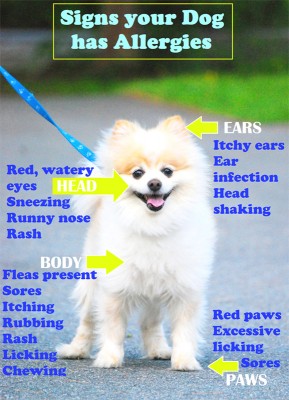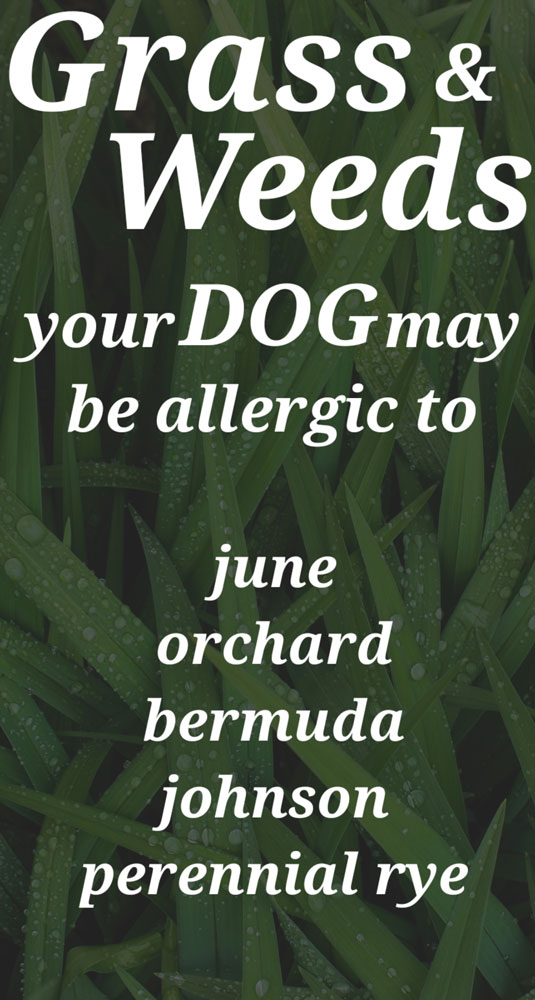Spring/Summer/Winter/Fall Allergies
Why is my dog sneezing and shaking his head? Why does my dog keep chewing on himself? The first question you may ask is “does my dog have seasonal allergies?” This question is the key to all other answers. In this article we will be discussing signs to look for to determine if your dog has allergies. Next, we will discuss which allergies are most common throughout the year, including spring and summer dog allergies.
What are Seasonal Dog Allergies?
Seasonal dog allergies are allergies present during certain seasons of the year. Pollen, dust, grass, and other irritants cause allergies. Looking for signs will help you determine if allergies are the problem. Watery eyes, scratching, sneezing, and rashes are common allergy symptoms. New seasons bring new allergies. For example, summer dog allergies can cause wheezing while winter allergies may cause sneezing.
Seasonal dog allergies are not to be confused with environmental allergies. Environmental allergies are caused by perfumes, cleaning products, certain plastics, fabrics, dog shampoos, and soaps. In contrast, season allergies are caused by foreign objects specific to the season.
Seasonal allergies should not be confused with digestive allergies. Foods can cause dog allergies. Allergies to certain foods may cause your dog to vomit, itch induce swelling, or diarrhea.
When your dog inhales an allergen inhalant atopic allergies occur. If your dog’s immune system overreacts to the allergen, they are considered atopic. The allergic reaction usually consists of itching or respiratory reactions like wheezing. This is considered a seasonal allergy because the inhaled airborne allergen is present during certain times of year. In addition, mold, pollen, and dust are among the most common.
Dog Spring Allergies
Common dog spring allergies are caused by the blossoming of flowers, grass, trees, weeds, and plants. Trees, grass, and weeds are the worst culprits. Spring pollinating trees include Juniper, Alder, Ash, Oak, Maple, Elm, and Willow. Grasses and weeds that sprout during the Spring are Orchard, Bermuda, June, Johnson, and Perennial Rye.
When trees, grasses, and weeds pollinate they release pollen into the air. Check below for an illustration of the different types of trees. Identifying trees around your house is important in ruling out a tree allergy. Even though pollen is carried through the air, it is best to keep your dog away from potential trees they may be sensitive to. Trees and grasses vary depending on your geographical location. Therefore influencing your dog’s spring allergies. For example, ash trees are more common in the Northeast while Willow trees are more common in the Southeast.
Dog Summer Allergies
Dog summer allergies include pollen and mold. Trees, grass, weeds, and ragweed are the most common generators of these allergies. Weeds and grasses are by far the worst. Pollen is released from the grasses and weeds as they grow and mature. Mold spores are released into the air from tree roots, plants stems, leaves, and mushrooms. Common weeds that cause allergic reactions are Ragweed, Sagebrush and Pigweed. Similarly, grasses that cause allergic reactions are Redtop, Orchard, Sweet Vemal, Timothy, and Bermuda.
The picture below illustrates different types of grasses/weeds we mentioned. Again, easier identification of grass and weeds is important. Weeds and grasses may vary depending on your geographical location. To sum up, it is best to keep your dog away from potential grasses/weeds they may be sensitive to.
Be aware of allergic reactions to bee stings during the summer time too. Some dogs experience no allergic reaction. However, they usually still experience some redness and discomfort. Alternatively, other dogs experience allergic reactions such as swelling. Benadryl can help with controlling an allergic reaction to bee stings.
Dog Fall Allergies
The most common dog fall allergy is Ragweed. But mold from falling and decaying leaves is also a concern. Keep your dog away if you think they’re allergic to mold and/or ragweed. Walk your dog on paved walkways, the beach, or pavement rather than at the park or hiking trails. Your dog may have an allergy to mold or ragweed if their symptoms improve as a result.
Dog Winter Allergies
If you live in a colder climate, chances are there isn’t any blossoming plant life outside to worry about during the winter. Thus your dog’s winter allergies should not be much of a concern. Focus on the allergens previously mentioned if you live in a climate that is warm year round because they can be present year round in warmer areas.
Mites, dust, smoke, feathers, or indoor mold cause seasonal dog allergies during the winter. Vacuum regularly to eliminate mites and dust. Don’t smoke around your dog, especially if your dog has an allergy to smoke. Feathers can also cause irritations so you should avoid feather filled beds, pillows, and blankets. Linens marked with the word down contain feathers. Water damage or ventilation issues cause moisture buildup resulting in mold production.
Signs and Symptoms of Dog Allergies
- Asthma
- Wheezing
- Coughing
- Excessive Licking
- Chewing
- Scratching
- Itchy/Red Inflamed Skin
- Ear Infections
- Sores
- Head Shaking
- Rubbing
- Runny Nose
- Water Eyes
- Red Eyes
- Sneezing
Signs and Symptoms of Dog Allergies on Specific Body Parts
- Ears – Your dog may scratch or rub their ears to satisfy itching. Too much scratching can cause sores in the ear. Fluids may build in the dog’s ear causing an infection.
- Head – Red, watery eyes, sneezing and/or a runny wet nose is common. A rash may be present on your dog’s head or around his eyes. Wheezing or coughing is also a common symptom of dog allergies. Your dog may be constantly shaking his head to relieve itching.
- Body – An itchy, red stomach could be a sign of a rash. Constant licking, rubbing, or chewing on certain body parts may occur. Licking and chewing is common when dogs try to relieve itching. Fleas may be present on your dog’s body. They are considered a seasonal allergy because they become more present during the warmer humid months. 70 to 80 degree whether is the prime temperature where fleas are most. If the humidity is high, such as 70%, it is even worse. If your dog scratches in excess, sores may be present.
- Paws – Your dog may have red paws and/or sores from scratching too much. In an attempt to relieve itchiness, chewing or licking of the paws is common.

If your dog is having an allergic reaction you may be able to treat him before consulting a Veterinarian. Please consult your Vet before using any at-home remedies though. Benadryl is the most commonly used at-home remedy. Being an antihistamine, it may lessen your dog’s irritation to an allergen. Read more information on giving your dog Benadryl and more at-home remedies here: Home Remedies for Dogs
Getting your Dog Tested and Examined at the Vet
Your Vet may provide several solutions depending on their testing/diagnosis of your dog. Mild to moderate seasonal allergies may be treated with Benadryl. Itching is often accompanied by inflammation and red skin. Your Veterinarian may suggest an omega 3 supplement for your dog. This will help decrease inflammation. In addition, omega 3 also helps improve your dog’s coat, skin, and immune system.
Cortisone shots may be administered if your dog is having a severe allergic reaction. Cortisone is an anti-allergen and anti-inflammatory agent. It’s stronger and works more quickly than oral medication. If your Veterinarian locates fleas, a bath will most likely be given a containing anti-flea shampoo as well as flea medicine.
It’s important to test, examine, and diagnose your dog at the Vet before starting treatment, medication, or supplements. There are steps you can take to see if there is improvement in your dog’s allergies before visiting the Vet.
Things to Try
- Vacuum, dust, and clean. We know this isn’t anyone’s favorite item on their to-do list, but it could provide great results. If your dog is having an irritation to dust, cleaning could eliminate the problem.
- Give your dog a bath. Who knows what could be on your dog’s coat after all that rolling around! Dogs can be affected by poison ivy/sumac/oak. Skin that is not covered by their coats, like their belly can get a rash. Bathing your dog will wash away any allergens from his/her coat. Poison ivy will take some time to clear up. Make sure your dog does not scratch too much causing open sores.
- Lastly, try an air purifier. Move the air purifier into the room where you think the culprit, like dust or mold spores are. Air purifiers are great at removing odors which will help if your dog is having a reaction to a perfume or an airborne chemical/cleaning spray in your home. We use a GermGuardian Air Purifier and as a result it has made a noticeable difference!
Watching your dog while out in the yard may provide insight on where the allergy may be coming from. It’s a good idea to track where your dog spends the most time inside. If your dog’s bed is near the baseboard or the bottom of your bed, look around. Is there dust or some other allergen. In conclusion, pay mind to your dog’s actions, whereabouts, and body. Ultimately it will provide the most information when trying to come up with a correct diagnosis.
Kimberly Mattar
March 12th, 2015
Last Updated on September 1st, 2020
Was this article helpful? Click for our other informative dog articles

Kim is the co-owner of DogLoverStore with her husband, John. She earned her BS in operations management at the University of Massachusetts Dartmouth. She enjoys walking in nature, gardening in the sun, eating sour candy, going on drives, yoga, and reading.


